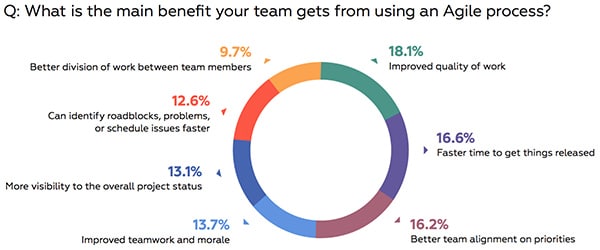 Wrike, the maker of work management tools for marketing and product development teams, has just released a survey of over 800 marketers across all disciplines called The State of Agile Marketing in 2016. It’s a fascinating study which confirms many of my own informal observations over the past six months.
Wrike, the maker of work management tools for marketing and product development teams, has just released a survey of over 800 marketers across all disciplines called The State of Agile Marketing in 2016. It’s a fascinating study which confirms many of my own informal observations over the past six months.
The Good News on Agile Marketing
According to Wrike’s survey data, over 70% of marketing teams are embracing some aspects of Agile Methods. That’s really high awareness and the beginnings of acceptance of Agile Marketing. Scott Brinker wrote recently that Agile Marketing has “crossed the chasm”. I’m not quite ready to call that crossing, but it does feel like Agile Marketing is starting to go mainstream.
Not surprisingly, most of the adoption of Agile Marketing has taken place recently. Over 55% of respondents who have adopted Agile Marketing started in the last six months or are just getting started.
Agile teams are seeing some great benefits: they listed the top three benefits as Improved quality of work, faster time to get things released and better team alignment on priorities.
One of the more intriguing findings, at least for me, was that heavy Agile adopters are significantly more satisfied with their work management than non-Agile adopters. 63% of heavy Agile users are very satisfied with work management compared to less than 10% of non-Agile adopters. I’ve heard this from a number of teams, but this is the first time I’ve seen it confirmed in survey results. This has some huge implications for employee satisfaction and retention, both of which should benefit from deep adoption of Agile methods.
Work To Be Done
Although I was very pleased at the awareness of Agile Marketing in general and the high satisfaction and clear benefits found by those who’ve adopted Agile Marketing, the survey also revealed that there is much work to be done for Agile to have the influence and impact on marketing that it has had on software development.
When asked, “What stops your team from more completely implementing an Agile approach?”, lack of training and knowledge about Agile was listed as the biggest barrier to implementing Agile. Running a close second (or first if you combine several categories) is complacency or an unwillingness to try new approaches, both by management and by marketers who are heads down too busy to try something new. It’s obvious that we need more evangelization of the benefits of Agile Marketing and more training.
A second issue is that even among those that practice Agile, most have not fully embraced Agile. Three-fourths of those who’ve adopted Agile methodologies say that they have tried some minor aspects of Agile marketing approaches or that they have been embracing some aspects of Agile methods. Only one-fourth of those adopting Agile methodologies seem to have fully embraced it to manage their work. This also shows up in the the survey results from the question about which Agile methodologies best describes what their team uses. Only 14% of teams hold regular, defined sprints with daily scrum meetings, retrospectives, and reviews – in other words, fully embracing Scrum and Agile.
The most popular methodology mentioned is Lean, which is described as “eliminate non value-added work or steps; optimize the ‘system’ for work; deliver as fast as possible”. I’m not entirely clear what Lean means in this context. If it means that people are rigorously adopting Eric Ries’s Build-Measure-Learn feedback loop, then I’m all for it. If they’re simply trying to deliver as fast as possible without any formal iterations or measurement, then I’m not sure I’d call that Agile.
While I don’t want to be the Agile police, I also don’t want people seeing Agile as just the next buzz word and convincing themselves that they’re practicing it, without really understanding what IT is.
The survey also makes clear that many teams have work to do in aligning marketing with Sales and Accounting/Finance. An “us vs. them” attitude, a lack of alignment on goals and priorities, and a failure to meet internal service delivery goals appear to be the major culprits. This is an area where I think Agile Marketing and particularly full Scrum can help tremendously, because it not only leads marketing to check with the Sales and business functions on priorities, but it communicates the work and accomplishments of marketing in a way that is often neglected. More about this in a future blog post.
All in all, I found this survey to be tremendously interesting, and I hope Wrike will conduct the survey again next year. Please reach out to them and get your own copy of the survey.




Pingback: Are We There Yet? Getting Agile Marketing Across the Chasm